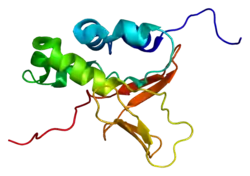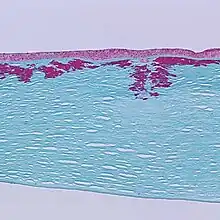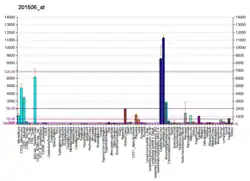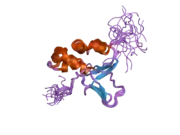TGFBI
Transforming growth factor, beta-induced, 68kDa, also known as TGFBI (initially called BIGH3, BIG-H3), is a protein which in humans is encoded by the TGFBI gene, locus 5q31.[5][6]
| TGFBI | |||||||||||||||||||||||||||||||||||||||||||||||||||
|---|---|---|---|---|---|---|---|---|---|---|---|---|---|---|---|---|---|---|---|---|---|---|---|---|---|---|---|---|---|---|---|---|---|---|---|---|---|---|---|---|---|---|---|---|---|---|---|---|---|---|---|
 | |||||||||||||||||||||||||||||||||||||||||||||||||||
| |||||||||||||||||||||||||||||||||||||||||||||||||||
| Identifiers | |||||||||||||||||||||||||||||||||||||||||||||||||||
| Aliases | TGFBI, BIGH3, CDB1, CDG2, CDGG1, CSD, CSD1, CSD2, CSD3, EBMD, LCD1, transforming growth factor beta induced | ||||||||||||||||||||||||||||||||||||||||||||||||||
| External IDs | OMIM: 601692 MGI: 99959 HomoloGene: 37294 GeneCards: TGFBI | ||||||||||||||||||||||||||||||||||||||||||||||||||
| |||||||||||||||||||||||||||||||||||||||||||||||||||
| |||||||||||||||||||||||||||||||||||||||||||||||||||
| |||||||||||||||||||||||||||||||||||||||||||||||||||
| |||||||||||||||||||||||||||||||||||||||||||||||||||
| |||||||||||||||||||||||||||||||||||||||||||||||||||
| Wikidata | |||||||||||||||||||||||||||||||||||||||||||||||||||
| |||||||||||||||||||||||||||||||||||||||||||||||||||
Function
This gene encodes an RGD-containing protein that binds to type I, II and IV collagens. The RGD motif is found in many extracellular matrix proteins modulating cell adhesion and serves as a ligand recognition sequence for several integrins. This protein plays a role in cell-collagen interactions and may be involved in endochondrial bone formation in cartilage. The protein is induced by transforming growth factor-beta and acts to inhibit cell adhesion.[5]
Clinical significance
Mutations of the gene cause several forms of corneal dystrophies.[7][8]

References
- GRCh38: Ensembl release 89: ENSG00000120708 - Ensembl, May 2017
- GRCm38: Ensembl release 89: ENSMUSG00000035493 - Ensembl, May 2017
- "Human PubMed Reference:". National Center for Biotechnology Information, U.S. National Library of Medicine.
- "Mouse PubMed Reference:". National Center for Biotechnology Information, U.S. National Library of Medicine.
- "Entrez Gene: TGFBI transforming growth factor, beta-induced, 68kDa".
- Munier FL, Korvatska E, Djemaï A, Le Paslier D, Zografos L, Pescia G, Schorderet DF (March 1997). "Kerato-epithelin mutations in four 5q31-linked corneal dystrophies". Nat. Genet. 15 (3): 247–51. doi:10.1038/ng0397-247. PMID 9054935. S2CID 19284412.
- Korvatska E, Munier FL, Djemaï A, Wang MX, Frueh B, Chiou AG, Uffer S, Ballestrazzi E, Braunstein RE, Forster RK, Culbertson WW, Boman H, Zografos L, Schorderet DF (February 1998). "Mutation hot spots in 5q31-linked corneal dystrophies". Am. J. Hum. Genet. 62 (2): 320–4. doi:10.1086/301720. PMC 1376896. PMID 9463327.
- Klintworth GK (2009). "Corneal dystrophies". Orphanet J Rare Dis. 4 (1): 7. doi:10.1186/1750-1172-4-7. PMC 2695576. PMID 19236704.
Further reading
- Fujiki K, Nakayasu K, Kanai A (2001). "Corneal dystrophies in Japan". J. Hum. Genet. 46 (8): 431–5. doi:10.1007/s100380170041. PMID 11501939.
- Schmitt-Bernard CF, Pouliquen Y, Argilès A (2004). "[BIG-H3 protein: mutation of codon 124 and corneal amyloidosis]". Journal français d'ophtalmologie. 27 (5): 510–22. doi:10.1016/S0181-5512(04)96173-6. PMID 15179309.
- Pieramici SF, Afshari NA (2006). "Genetics of corneal dystrophies: the evolving landscape". Current Opinion in Ophthalmology. 17 (4): 361–6. doi:10.1097/01.icu.0000233955.94347.84. PMID 16900028. S2CID 9671230.
- Skonier J, Neubauer M, Madisen L, et al. (1992). "cDNA cloning and sequence analysis of beta ig-h3, a novel gene induced in a human adenocarcinoma cell line after treatment with transforming growth factor-beta". DNA Cell Biol. 11 (7): 511–22. doi:10.1089/dna.1992.11.511. PMID 1388724.
- LeBaron RG, Bezverkov KI, Zimber MP, et al. (1995). "Beta IG-H3, a novel secretory protein inducible by transforming growth factor-beta, is present in normal skin and promotes the adhesion and spreading of dermal fibroblasts in vitro". J. Invest. Dermatol. 104 (5): 844–9. doi:10.1111/1523-1747.ep12607024. PMID 7738366.
- Skonier J, Bennett K, Rothwell V, et al. (1994). "beta ig-h3: a transforming growth factor-beta-responsive gene encoding a secreted protein that inhibits cell attachment in vitro and suppresses the growth of CHO cells in nude mice". DNA Cell Biol. 13 (6): 571–84. doi:10.1089/dna.1994.13.571. PMID 8024701.
- Escribano J, Hernando N, Ghosh S, et al. (1994). "cDNA from human ocular ciliary epithelium homologous to beta ig-h3 is preferentially expressed as an extracellular protein in the corneal epithelium". J. Cell. Physiol. 160 (3): 511–21. doi:10.1002/jcp.1041600314. PMID 8077289. S2CID 21442005.
- Maruyama K, Sugano S (1994). "Oligo-capping: a simple method to replace the cap structure of eukaryotic mRNAs with oligoribonucleotides". Gene. 138 (1–2): 171–4. doi:10.1016/0378-1119(94)90802-8. PMID 8125298.
- Stone EM, Mathers WD, Rosenwasser GO, et al. (1994). "Three autosomal dominant corneal dystrophies map to chromosome 5q". Nat. Genet. 6 (1): 47–51. doi:10.1038/ng0194-47. PMID 8136834. S2CID 44641005.
- Munier FL, Korvatska E, Djemaï A, et al. (1997). "Kerato-epithelin mutations in four 5q31-linked corneal dystrophies". Nat. Genet. 15 (3): 247–51. doi:10.1038/ng0397-247. PMID 9054935. S2CID 19284412.
- Hashimoto K, Noshiro M, Ohno S, et al. (1997). "Characterization of a cartilage-derived 66-kDa protein (RGD-CAP/beta ig-h3) that binds to collagen". Biochim. Biophys. Acta. 1355 (3): 303–14. doi:10.1016/S0167-4889(96)00147-4. PMID 9061001.
- Suzuki Y, Yoshitomo-Nakagawa K, Maruyama K, et al. (1997). "Construction and characterization of a full length-enriched and a 5'-end-enriched cDNA library". Gene. 200 (1–2): 149–56. doi:10.1016/S0378-1119(97)00411-3. PMID 9373149.
- Korvatska E, Munier FL, Djemaï A, et al. (1998). "Mutation hot spots in 5q31-linked corneal dystrophies". Am. J. Hum. Genet. 62 (2): 320–4. doi:10.1086/301720. PMC 1376896. PMID 9463327.
- Yamamoto S, Okada M, Tsujikawa M, et al. (1998). "A kerato-epithelin (betaig-h3) mutation in lattice corneal dystrophy type IIIA". Am. J. Hum. Genet. 62 (3): 719–22. doi:10.1086/301765. PMC 1376959. PMID 9497262.
- Okada M, Yamamoto S, Watanabe H, et al. (1998). "Granular corneal dystrophy with homozygous mutations in the kerato-epithelin gene". Am. J. Ophthalmol. 126 (2): 169–76. doi:10.1016/S0002-9394(98)00075-0. PMID 9727509.
- Okada M, Yamamoto S, Tsujikawa M, et al. (1998). "Two distinct kerato-epithelin mutations in Reis-Bücklers corneal dystrophy". Am. J. Ophthalmol. 126 (4): 535–42. doi:10.1016/S0002-9394(98)00135-4. PMID 9780098.
- Fujiki K, Hotta Y, Nakayasu K, et al. (1998). "A new L527R mutation of the betaIGH3 gene in patients with lattice corneal dystrophy with deep stromal opacities". Hum. Genet. 103 (3): 286–9. doi:10.1007/s004390050818. PMID 9799082. S2CID 23721847.
- Stewart H, Black GC, Donnai D, et al. (1999). "A mutation within exon 14 of the TGFBI (BIGH3) gene on chromosome 5q31 causes an asymmetric, late-onset form of lattice corneal dystrophy". Ophthalmology. 106 (5): 964–70. doi:10.1016/S0161-6420(99)00539-4. PMID 10328397.
- Stewart HS, Ridgway AE, Dixon MJ, et al. (1999). "Heterogeneity in granular corneal dystrophy: identification of three causative mutations in the TGFBI (BIGH3) gene-lessons for corneal amyloidogenesis". Hum. Mutat. 14 (2): 126–32. doi:10.1002/(SICI)1098-1004(1999)14:2<126::AID-HUMU4>3.0.CO;2-W. PMID 10425035. S2CID 30001550.
- Rozzo C, Fossarello M, Galleri G, et al. (2000). "A common beta ig-h3 gene mutation (delta f540) in a large cohort of Sardinian Reis Bücklers corneal dystrophy patients. Mutations in brief no. 180. Online". Hum. Mutat. 12 (3): 215–6. PMID 10660331.
- Page L, Polok B, Bustamante M, Schorderet DF (2013). "Bigh3 is upregulated in regenerating zebrafish fin". Zebrafish. 10 (3): 36–42. doi:10.1089/zeb.2012.0759. PMID 23536989.
This article incorporates text from the United States National Library of Medicine, which is in the public domain.





